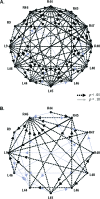Task-dependent individual differences in prefrontal connectivity
- PMID: 20064942
- PMCID: PMC2923215
- DOI: 10.1093/cercor/bhp284
Task-dependent individual differences in prefrontal connectivity
Abstract
Recent advances in neuroimaging have permitted testing of hypotheses regarding the neural bases of individual differences, but this burgeoning literature has been characterized by inconsistent results. To test the hypothesis that differences in task demands could contribute to between-study variability in brain-behavior relationships, we had participants perform 2 tasks that varied in the extent of cognitive involvement. We examined connectivity between brain regions during a low-demand vigilance task and a higher-demand digit-symbol visual search task using Granger causality analysis (GCA). Our results showed 1) Significant differences in numbers of frontoparietal connections between low- and high-demand tasks 2) that GCA can detect activity changes that correspond with task-demand changes, and 3) faster participants showed more vigilance-related activity than slower participants, but less visual-search activity. These results suggest that relatively low-demand cognitive performance depends on spontaneous bidirectionally fluctuating network activity, whereas high-demand performance depends on a limited, unidirectional network. The nature of brain-behavior relationships may vary depending on the extent of cognitive demand. High-demand network activity may reflect the extent to which individuals require top-down executive guidance of behavior for successful task performance. Low-demand network activity may reflect task- and performance monitoring that minimizes executive requirements for guidance of behavior.
Figures





References
-
- Allen G, McColl R, Barnard H, Ringe WK, Fleckenstein J, Cullum CM. Magnetic resonance imaging of cerebellar-prefrontal and cerebellar-parietal functional connectivity. Neuroimage. 2005;28:39–48. - PubMed
-
- Babiloni C, Del Percio C, Rossini PM, Marzano N, Iacoboni M, Infarinato F, Lizio R, Piazza M, Pirritano M, Berlutti G, et al. Judgment of actions in experts: a high-resolution EEG study in elite athletes. Neuroimage. 2009;45:512–521. - PubMed
-
- Baddeley AD. Working Memory. NY: Oxford University Press; 1986.
-
- Beck A, Steer R. Manual for the Beck Depression Inventory. San Antonio (TX): Psychological Corporation. 1987
-
- Benjamini Y, Yekutieli D. The control of the false discovery rate in multiple testing under dependency. Ann Stat. 2001;29:1165–1188.

